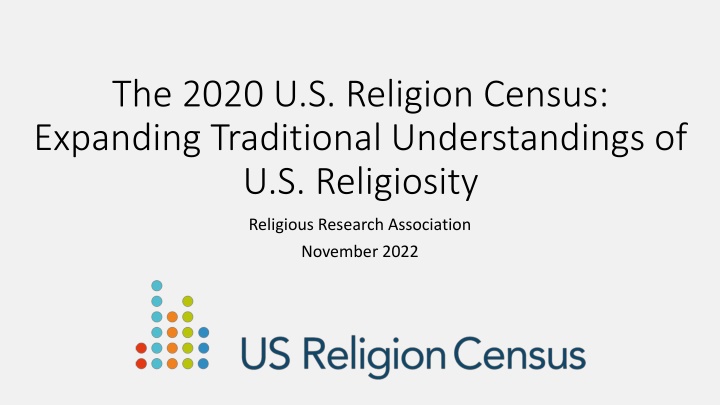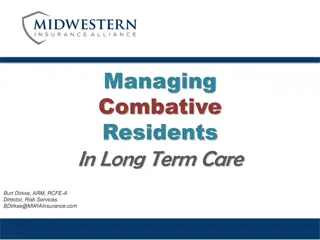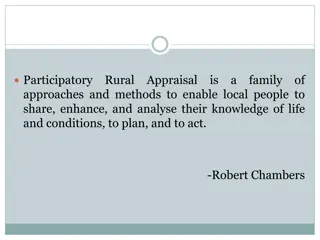
Insights from the 2020 U.S. Religion Census
Discover the key findings and efforts to expand traditional understandings of U.S. religiosity through the 2020 U.S. Religion Census. Learn about congregationally based data on 372 religious bodies, including unique distinctions and improvements, and the decennial series from 1952 to present, providing continuity and local area data on religious bodies.
Download Presentation

Please find below an Image/Link to download the presentation.
The content on the website is provided AS IS for your information and personal use only. It may not be sold, licensed, or shared on other websites without obtaining consent from the author. If you encounter any issues during the download, it is possible that the publisher has removed the file from their server.
You are allowed to download the files provided on this website for personal or commercial use, subject to the condition that they are used lawfully. All files are the property of their respective owners.
The content on the website is provided AS IS for your information and personal use only. It may not be sold, licensed, or shared on other websites without obtaining consent from the author.
E N D
Presentation Transcript
The 2020 U.S. Religion Census: Expanding Traditional Understandings of U.S. Religiosity Religious Research Association November 2022
Session Outline Introduction to the U.S. Religion Census The U.S. Religion Census: Efforts to Expand Rich Houseal, Church of the Nazarene Research Center Cliff Grammich, U.S. Religion Census My Religious Tradition s Buffet of Gelatinous Fare: The Art of Bounding and Enumerating 100+ Conservative and Plain Anabaptist Groups Cory Anderson, Amish and Plain Anabaptist Studies Association Orthodox Christian Churches in the USA: What Happened between 2010 and 2020? Alexei Krindatch, National Census of Orthodox Christian Churches
The U.S. Religion Census: An ASARB Production Since 1990, the U.S. Religion Census has been conducted by the Association of Statisticians of American Religious Bodies (ASARB) ASARB Religion Census Operations Committee Members are Erica Dollhopf, United Church of Christ Mary Gautier, CARA at Georgetown University (Catholic) Cliff Grammich, Glenmary Research Center (Catholic) Rich Houseal, Church of the Nazarene Dale Jones, Church of the Nazarene Alexei Krindatch, U.S. Census of Orthodox Christian Churches Richie Stanley, Southern Baptist Convention Scott Thumma, Hartford Institute for Religion Research
U.S. Religion Census Continues a (Roughly) Decennial Series from 1952 to Present Data for 1952, 1971, 1980, 1990, 2000, 2010, and today, 2020 Features of data include Continuity: many bodies also have data in similar earlier series by U.S. Census Bureau on Religious Bodies Local area (county-level) data for entire nation Unique distinctions among religious bodies, including Multiple bodies from different Protestant traditions Improvements in other Christian bodies Increasing representation of non-Christian bodies
Data Are Congregationally Based Congregations: groups of individuals who meet regularly (typically weekly) at a pre-announced time and location, e.g., churches, mosques, temples, or other meeting places Adherents: most complete count of individuals affiliated with a congregation, including members, children of members, other attendees who are not members; may require estimation procedure For 2020, we have data on 372 religious bodies, from the Advent Christian Church to Zoroastrianism Congregations and adherents for 216 religious bodies Congregations only for 156 religious bodies
2020 Religion Census Is the Most Inclusive to Date Year Participating Bodies Congregations Individuals* U.S. Population 1952 114 182,856 74,125,462 150,697,361 1971 53 182,335 98,979,097 203,392,031 1980 1990 111 133 231,708 255,173 112,538,310 137,064,509 226,545,805 248,709,873 2000 149 268,254 141,371,963 281,421,906 2010 236 344,894 150,596,792 308,745,538 2020 372 356,739 161,371,931 331,449,281 *members in 1952; adherents all other years
For Further Information, see . . . USReligionCensus.org facebook.com/USReligionCensus twitter.com/ReligionCensus instagram.com/usreligioncensus asarb.org thearda.com nazarene.org/research orthodoxreality.org amishstudies.org glenmary.org or grc@glenmary.org (for wall maps) USReligionCensus.org QR code
The 2020 U.S. Religion Census: Broad Implications for Clergy Religious Research Association November 2022
Session Outline Introduction to the U.S. Religion Census Evangelical and Mainline Protestants in the U.S. Religion Census Rich Houseal, Church of the Nazarene Research Center Catholics in the U.S. Religion Census Cliff Grammich, Glenmary Research Center Interpreting USRC Data on Adherents Erica Dollhopf, United Church of Christ Center for Analytics, Research & Development, and Data What Do My Neighbors Believe? Using the U.S. Religion Census to Better Understand My Community Dale Jones, U.S. Religion Census
The U.S. Religion Census: An ASARB Production Since 1990, the U.S. Religion Census has been conducted by the Association of Statisticians of American Religious Bodies (ASARB) ASARB Religion Census Operations Committee Members are Erica Dollhopf, United Church of Christ Mary Gautier, CARA at Georgetown University (Catholic) Cliff Grammich, Glenmary Research Center (Catholic) Rich Houseal, Church of the Nazarene Dale Jones, Church of the Nazarene Alexei Krindatch, U.S. Census of Orthodox Christian Churches Richie Stanley, Southern Baptist Convention Scott Thumma, Hartford Institute for Religion Research
U.S. Religion Census Continues a (Roughly) Decennial Series from 1952 to Present Data for 1952, 1971, 1980, 1990, 2000, 2010, and today, 2020 Features of data include Continuity: many bodies also have data in similar earlier series by U.S. Census Bureau on Religious Bodies Local area (county-level) data for entire nation Unique distinctions among religious bodies, including Multiple bodies from different Protestant traditions Improvements in other Christian bodies Increasing representation of non-Christian bodies
Data Are Congregationally Based Congregations: groups of individuals who meet regularly (typically weekly) at a pre-announced time and location, e.g., churches, mosques, temples, or other meeting places Adherents: most complete count of individuals affiliated with a congregation, including members, children of members, other attendees who are not members; may require estimation procedure For 2020, we have data on 372 religious bodies, from the Advent Christian Church to Zoroastrianism Congregations and adherents for 216 religious bodies Congregations only for 156 religious bodies
2020 Religion Census Is the Most Inclusive to Date Year Participating Bodies Congregations Individuals* U.S. Population 1952 114 182,856 74,125,462 150,697,361 1971 53 182,335 98,979,097 203,392,031 1980 1990 111 133 231,708 255,173 112,538,310 137,064,509 226,545,805 248,709,873 2000 149 268,254 141,371,963 281,421,906 2010 236 344,894 150,596,792 308,745,538 2020 372 356,739 161,371,931 331,449,281 *members in 1952; adherents all other years
For Further Information, see . . . USReligionCensus.org facebook.com/USReligionCensus twitter.com/ReligionCensus instagram.com/usreligioncensus asarb.org thearda.com nazarene.org/research www.ucc.org/what-we-do/office-of-the-general-minister-president/center- for-analytics-research-and-development-and-data- cardd/orthodoxreality.org glenmary.org or grc@glenmary.org (for wall maps) USReligionCensus.org QR code









